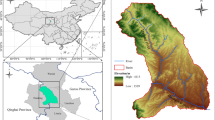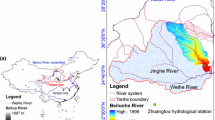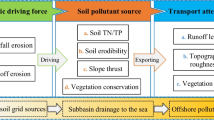Abstract
The runoff-sediment relationship in the Yellow River Basin of China is still grim. People pay more and more attention to non-point source (NPS) pollution caused by surface pollutants migrating into the receiving water body with rainfall runoff. The particulate load of pollutants adsorbed in the soil and sediment by erosion and denudation and migration into water is also quite serious. It is necessary to deeply analyze the quantitative relationship between particulate nitrogen and phosphorus (PN/PP) load and soil loss. The soil erosion estimation of different administrative units in the study basin is obtained by the revised universal soil loss equation (RUSLE). The spatial distribution and the variation characteristics at different slopes and different land use of PN/PP load are discussed. An empirical equation of particulate organic load is used to calculate the PN/PP load. The results show that the multi-annual average erosion modulus of the basin is 358.33 t/(km2∙a); the multi-annual average soil erosion reaches 9.62 million tons. The PN/PP load caused by soil loss reaches 11,107.1 t and 7909.3 t, and the export coefficients are 4.13 kg/hm2 and 2.94 kg/hm2, respectively. Spatial distribution of the PN/PP load is in step with the soil erosion distribution. Soil erosion is prone to occur in the region under the slope of 8 ~ 25°, the NPS load of PN/PP are relatively large, and the average export coefficients of PN/PP are 7.17 kg/hm2 and 5.06 kg/hm2. With the increase of the slope, the PN/PP load export coefficient increases first and then decreases. Agricultural land (AGRL), forest land (FRST), and pasture (PAST) are the land use types that contribute the most to the PN/PP load and soil erosion, and the average export coefficients of PN/PP are 4.54 kg/hm2 and 3.23 kg/hm2, respectively. The variability of natural elements, the unevenness and heterogeneity of spatial distribution, and the heavy involvement of human activities will have a conspicuous impact on the soil erosion and NPS pollution processes in the basin. The research on the influence of single factor and combined factors on NPS pollution process can be strengthen and provides scientific theoretical basis for formulating reasonable and efficient water and soil conservation measures and NPS pollution control scheme, so as to achieve effective control and scientific management of environment pollution.








Similar content being viewed by others
References
Amundson R, Berhe AA, Hopmans JW, Olson C, Sztein AE, Sparks DL (2015) Soil and human security in the 21st century. Science 348(6235):6
Cai CF, Ding SW, Shi ZH, Huang L, Zhang GY (2000) Study of applying USLE and geographical information system IDRISI to predict soil erosion in small watershed. J Soil Water Conserv 14(2):20–25 (in Chinese)
Chen N, Li TB, Zhang XP, Chou SR, Xie ML, Liu EJ (2013) Spatiotemporal variations of vegetation coverage in Beiluo River watershed based on remote sensing date analysis. B Soil Water Conserv 33(3):206–210 (in Chinese)
Cheng JR (2018) Application research on USLE soil erosion model in Ta-pieh Mountains area. Nanjing Forestry University, Nanjing (in Chinese)
Cheng YT, Li P, Xu GC, Li ZB, Cheng SD, Wang B, Zhao BH (2019) Spatial and temporal stability of temperature in the first-level basins of China during 1951–2013. Theor Appl Climatol 136:863–874
Christine A, Pasquale B, Katrin M, Panos P (2019) Using the USLE: chances, challenges and limitations of soil erosion modelling. Int Soil Water Conserv Res 7:203–225
Demirci A, Karaburun A (2012) Estimation of soil erosion using RUSLE in a GIS framework: a case study in the Buyukcekmece Lake watershed, Northwest Turkey. Environ Earth Sci 66(3):903–913
FAO (2015) GLADIS - global land degradation information system
Guo DW, Yu BF, Fu XD, Li TJ, ASCE AM (2015) Improved Hillslope Erosion module for the digital Yellow–River model. J Hydrol Eng 20(6):C4014011
Hao G, Li J, Song L, Li H, Li Z (2018) Comparison between the TOPMODEL and the Xin’anjiang model and their application to rainfall runoff simulation in semi-humid regions. Environ Earth Sci 77(7):279
Hessel R, Jetten V, Liu BY, Zhang Y, Stolte J (2003) Calibration of the LISEM model for a small loess plateau catchment. Catena 54(1–2):235–254
Hu S (2015) Simulation and prediction research of the ecohydrological process based on SWAT model in Beiluo River Basin. Northwest University, Xi’an (in Chinese)
Hua L, Li W, Zhai L, Yen H, Lei Q, Liu H, Ren T, Xia Y, Zhang F, Fan X (2019) An innovative approach to identifying agricultural pollution sources and loads by using nutrient export coefficients in watershed modeling. J Hydrol 571:322–331
Huang J, Yao ZH, Zha SX, Xiao PQ, Wang B (2020) Progress of study on soil and water conservation measure factors in USLE/RUSLE. Soil Water Conserv China 3(456):37–39 (in Chinese)
Institute of Soil Science, Chinese Academy of Sciences (2015) China Soil Database, http://vdb3.soil.csdb.cn/
Jiang XF, Wang L, Ma F, Li HQ, Liang XW (2014) Localization method for SWAT model soil database based on HWSD. China Water Wastewater 30(11):135–138 (in Chinese)
Keesstra SD, Bouma J, Wallinga J, Tittonell P, Smith P, Cerda A, Montanarella L, Quinton JN, Pachepsky WH, Putten A, Bardgett RD, Moolenaar S, Mol G, Jansen B, Fresco LO (2016) The significance of soils and soil science towards realization of the United Nations sustainable development goals. Soil 2(2):111–128
Li HE, Li JK (2013) Research and application of quantification method for non-point source pollution load in watershed. Science Press, Beijing (in Chinese)
Li TH, Zheng LL (2012) Soil erosion changes in the Yanhe watershed from 2001 to 2010 based on RUSLE model. J Nat Res 27(7):1164–1175 (in Chinese)
Li W, Zhai L, Lei Q, Wollheim WM, Liu J, Liu H, Hu W, Ren T, Wang H, Liu S (2018) Influences of agricultural land use composition and distribution on nitrogen export from a subtropical watershed in China. Sci Total Environ 642:21–32
Liu BY, Nearing MA, Risse LM (2000) Slope gradient effects on soil loss for steep slopes. Soil Sci Soc Am J 64(5):1759–1763
McCool DK, Brown LC, Foster GR, Mutchler CK, Meyer LD (1987) Revised slope steepness factor for the universal soil loss equation. Trans ASAE 30(5):1387–1396
Ouyang W, Hao F, Skidmore AK, Toxopeus AG (2010) Soil erosion and sediment yield and their relationships with vegetation cover in upper stream of the Yellow River. Sci Total Environ 409(2):396–403
Renard KG, Foster GR, Weesies GA, McCool DK, Yoder DC (1997) Predicting soil erosion by water: a guide to conservation planning with the revised universal soil loss equation (RUSLE). Agricultural handbook 703, USDA
Shen H, Zhang WS, Peng H (2010) Research on soil Erosion and particulate phosphorus load of non-point source pollution in the middle and lower reaches of the Hanjiang River basin. Res Soil Water Conserv 17(2):1–6 (in Chinese)
Shi ZH, Cai CF, Ding SW, Li ZX, Wang TW, Zhang B, Sheng XL (2002) Research on nitrogen and phosphorus load of agriculture non-point sources in middle and lower reachs of Hanjiang River based on GIS. Acta Sci Circumst 22(4):473–477 (in Chinese)
Shi W, Huang M, Barbour SL (2018) Storm-based CSLE that incorporates the estimated runoff for soil loss prediction on the Chinese Loess Plateau. Soil Tillage Res 180:137–147
Smith DD, Wischmeier WH (1957) Factor’s affecting sheet and rill erosion. Trans Am Geophys Union 38(6):889–896
Sun P, Wu Y, Yang Z, Bellie S, Qiu L, Liu S, Cai Y (2019) Can ‘Grain-for-Green’ program really ensure a low sediment load on the Chinese Loess Plateau? Engineering 5:855–864
Wang T (2018) Quantitative analysis on influencing factors of soil erosion using RUSLE: a case study of the Luohe basin in northern Shanxi Province. Environ Sci Technol 41(8):170–177 (in Chinese)
Wang T, Lei G, Liu YC, Meng X, Zhang ZP, Wu T, Wu YY (2015) Influence of grain for green policy on soil erosion in Yan’an area. Chinese Agr Sci Bull 31(23):162–170 (in Chinese)
Williams JR, Renard KG, Dyke PT (1983) EPIC: a new method for assessing erosion's effect on soil productivity. J Soil Water Conserv 38(5):381–383
Wischmeier WH, Smith DD (1978) Predicting rainfall erosion losses: a guide to conservation planning with Universal Soil Loss Equation (USLE). Agriculture Handbook
Wu Y, Chen J (2012) Modeling of soil erosion and sediment transport in the East River Basin in southern China. Sci Total Environ 441:159–168
Wu Y, Chen J (2013) Investigating the effects of point source and nonpoint source pollution on the water quality of the East River (Dongjiang) in South China. Ecol Indic 32:294–304
Wu L, Li PC, Ma XY (2016) Estimating nonpoint source pollution load using four modified export coefficient models in a large easily eroded watershed of the loess hilly–gully region, China. Environ Earth Sci 75(13):1056
Xu ZX (2009) Hydrological Models. Science Press, Beijing (in Chinese)
Xu XL (2018) China annually vegetation index (NDVI) spatial distribution data set. Beijing: Chinese Academy of Sciences resource and environmental science data center data registration and publishing system, http://www.resdc.cn/DOI. https://doi.org/10.12078/2018060602
Xu Y, Li HE, Ni Y, Yang F (2006) Estimate on pollution loadings of nitrogen and phosphorus based on USLE in Heihe River watershed. J Northwest A&F Univ (Nat Sci Ed) 34(3):138–142 (in Chinese)
Xue SL (2006) Simulation the non-point pollution load of nitrogen and phosphorus in the Heihe watershed basin on GIS. Xi’an University of technology, Xi’an. (in Chinese)
Yan R, Zhang XP, Li GX, Chen H (2017) Soil erosion and sediment yield assessment based on RUSLE in Beiluo River on the Loess Plateau, China. J Soil Water Conserv 31(4):32–37 (in Chinese)
Zhang H, Zhang R, Qi F, Liu X, Niu Y, Fan ZF, Zhang QH, Li JZ, Yuan L, Song YY, Yang SY, Yao XY (2018) The CSLE model based soil erosion prediction: comparisons of sampling density and extrapolation method at the county level. Catena 165:465–472
Zhang BJ, Zhang GH, Yang HY, Wang H (2019) Soil resistance to flowing water erosion of seven typical plant communities on steep gully slopes on the Loess Plateau of China. Catena 173:375–383
Zhuang YH, Hong S, Zhang WT, Lin HY, Zeng QH, Nguyen T, Niu BB, Li WY (2013) Simulation of the spatial and temporal changes of complex non-point source loads in a lake watershed of central China. Water Sci Technol 67(9):2050–2057
Zuo DP, Xu ZX, Peng DZ, Song JX, Cheng L, Wei SL, Abbaspour KC, Yang H (2014) Simulating spatiotemporal variability of blue and green water resources availability with uncertainty analysis. Hydrol Process 29(8):1942–1955
Funding
This research was supported by the Key Research and Development Project of Shaanxi Province (2019ZDLSF06-01) and the National Natural Science Foundation of China (51879215).
Author information
Authors and Affiliations
Corresponding author
Additional information
Responsible editor: Marcus Schulz
Publisher’s note
Springer Nature remains neutral with regard to jurisdictional claims in published maps and institutional affiliations.
Rights and permissions
About this article
Cite this article
Hao, Gr., Li, Jk., Li, S. et al. Quantitative assessment of non-point source pollution load of PN/PP based on RUSLE model: a case study in Beiluo River Basin in China. Environ Sci Pollut Res 27, 33975–33989 (2020). https://doi.org/10.1007/s11356-020-09587-2
Received:
Accepted:
Published:
Issue Date:
DOI: https://doi.org/10.1007/s11356-020-09587-2




